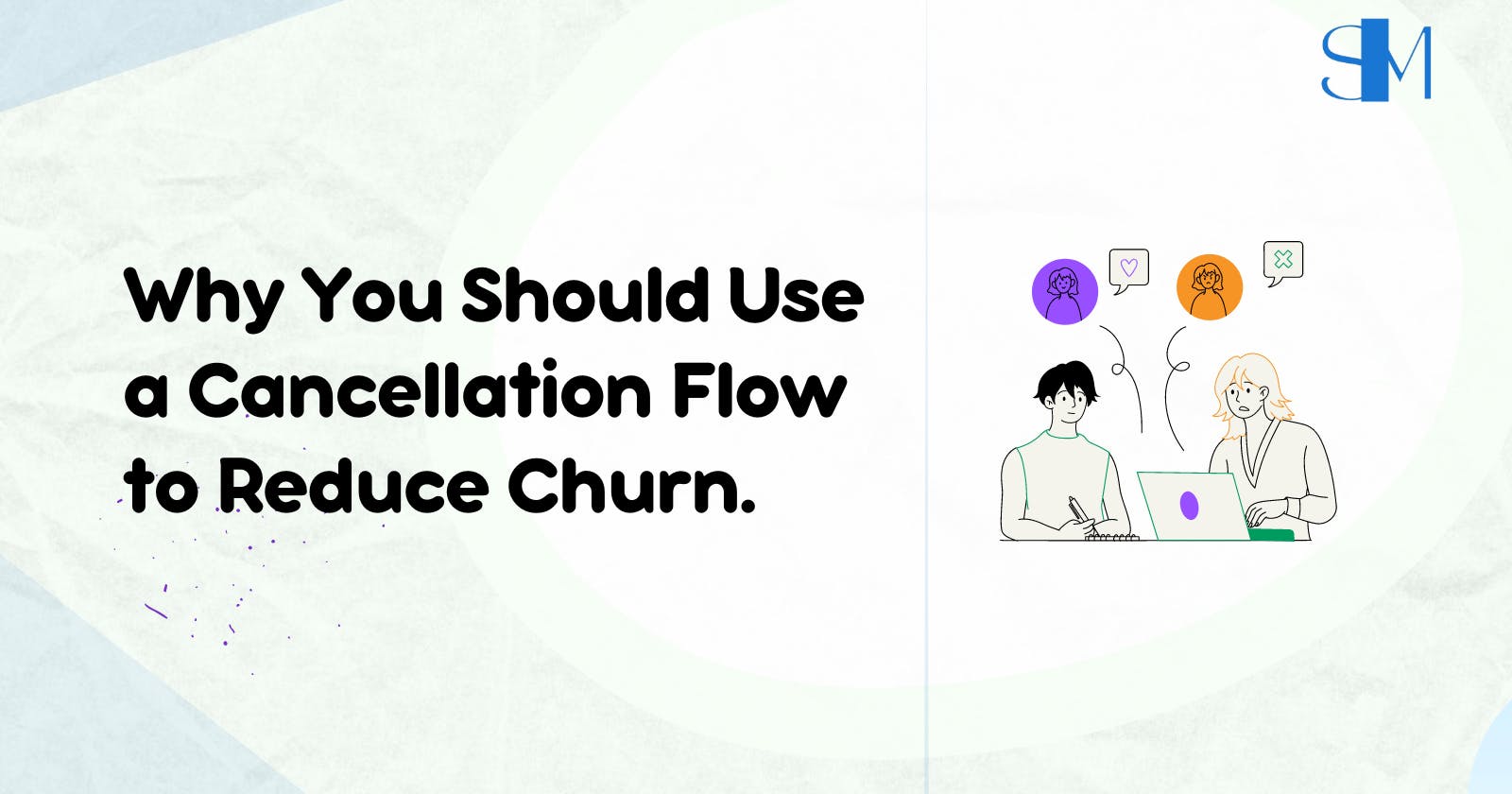Why You Should Use a Cancellation Flow to Reduce Churn.
Maximize Retention and Customer Satisfaction with Effective Churn Management Strategies
Customer churn isn't an uncommon topic in B2B SaaS businesses. People stop using your product for a variety of reasons. But you don't want them to leave with distrust and anger toward your company, as it may compel them to spread negative word of mouth about your product. That's where the cancellation process comes in handy.
A good cancellation process not only allows determined customers to cancel smoothly and positively, but also gives you the opportunity to retain them by giving them compelling reasons as to why they should continue to register. The “cancel” button does not mean the end of the relationship with your customer. Instead, this is an opportunity to find a new balance that works for both of you.
What is a cancellation flow?
A cancellation flow is the sequence of actions you want your customers to take after they initiate a cancellation request with your business. It typically begins at the moment your customer indicates intent to visit your cancellation page and continues well beyond the point where the customer has likely churned or successfully unsubscribed from your product.
Why is setting up a cancellation flow important for your company?
The cancellation flow should continuously analyze the outcomes and feed actionable insights back into your other business systems to optimize them in the future. The intention to terminate your business is strong, so to give you the best opportunity to change their mind, your cancellation flow should help them feel heard and valued as they move through the next steps of their journey. Your cancellation flow should be white-glove assistance throughout the process. This includes collecting feedback, acknowledging their issues and offering an alternative solution, and, at the business end, alerting your customer success team to provide you with a fighting chance to reconversion and provide clear and concise insights on how to prevent similar situations from occurring in the future.
Gathering User Feedback
Customers abandoning their SaaS subscriptions isn't the worst situation. Churn rates for B2B SaaS companies can range from 4–10% per month.
It's, however, important for you to understand why people leave you so you can optimize your offer for other users and hope they won't unsubscribe for the same reason.
So always use exit surveys to ask about their decision before unsubscribing. Customer success teams can use customer feedback to improve service and reduce future losses.
For example, you may discover information about the incomplete or missing features or functionality of your product or service. From there, you can figure out how to add new features to your product or improve existing ones.
Gaining Trust with Respecting their Choice
The goal of cancellation flows is to lower customer churn rates and prevent cancellations. However, this is done so that clients have total authority over their choices. You take away their ability to decide for themselves what's best for them by making them stick with their membership.
If that's the case, you'll annoy every single one of your clients—even the most devoted ones—and they will all choose not to use your services. In order to win them back, the best you can do with a cancellation flow is to remind them of the true worth of your good or service and present a substitute.
Opening Door for future
Customers may still visit us in the future, even after they terminate their memberships. With cancellation flows, you can honor your clients' time with you and bid them farewell in a dignified manner.
Your subsequent demonstration of class will open the door for their future reappearance in a few months or years. Additionally, you may be more aggressive and use the reasons behind their departure to your advantage to re-engage and win them back as subscribers.
Best practices for setting up a cancellation process
Here's a rundown of the fundamental aspects you need to keep in mind when organizing your cancellation plan.
Make initial contact easier
It is necessary to obtain customer consent before transferring renewal emails or automatically renewing them. A "cancel" button must also be easily accessible to ensure regulatory compliance and gain customer trust. Obfuscating the cancel button can have the opposite effect on customer loyalty, quickly erode customer trust in your business, and government intervention can lead to serious compliance issues (in addition to customer anger).
Design Creative Exit Surveys
Rather than only providing multiple-choice option in your survey, set "Other" field within the cancellation reason for an exit survey that allows customers to expand on their exit survey responses.
These are extremely valuable not only for gaining a deeper understanding of customer sentiment but also for gathering first-hand information about products and services, as both products and customer expectations are constantly changing.
The final survey responses should also be dynamic. Repeat exit survey response options over and over again to accurately represent and understand changing market/customer sentiment.
Customize the offer based upon Exit reasons
Use insights from cancellation surveys to present offers that match cancellation intent. For example, if high price is the reason for cancellation, you can offer a percentage or amount discount on the subscription, or even a free month.
However, if the reason for cancellation indicates that the customer is not getting value from the product, you can trigger automated workflows for your customer success team to better demonstrate value and benefit.
Confirm Cancellation
If the customer wishes to cancel, you can obtain confirmation and proceed with the final steps of the process. However, this is also a good time to remind your customers of the benefits your company brings to them and offer them the option to pause their subscription instead of canceling it.
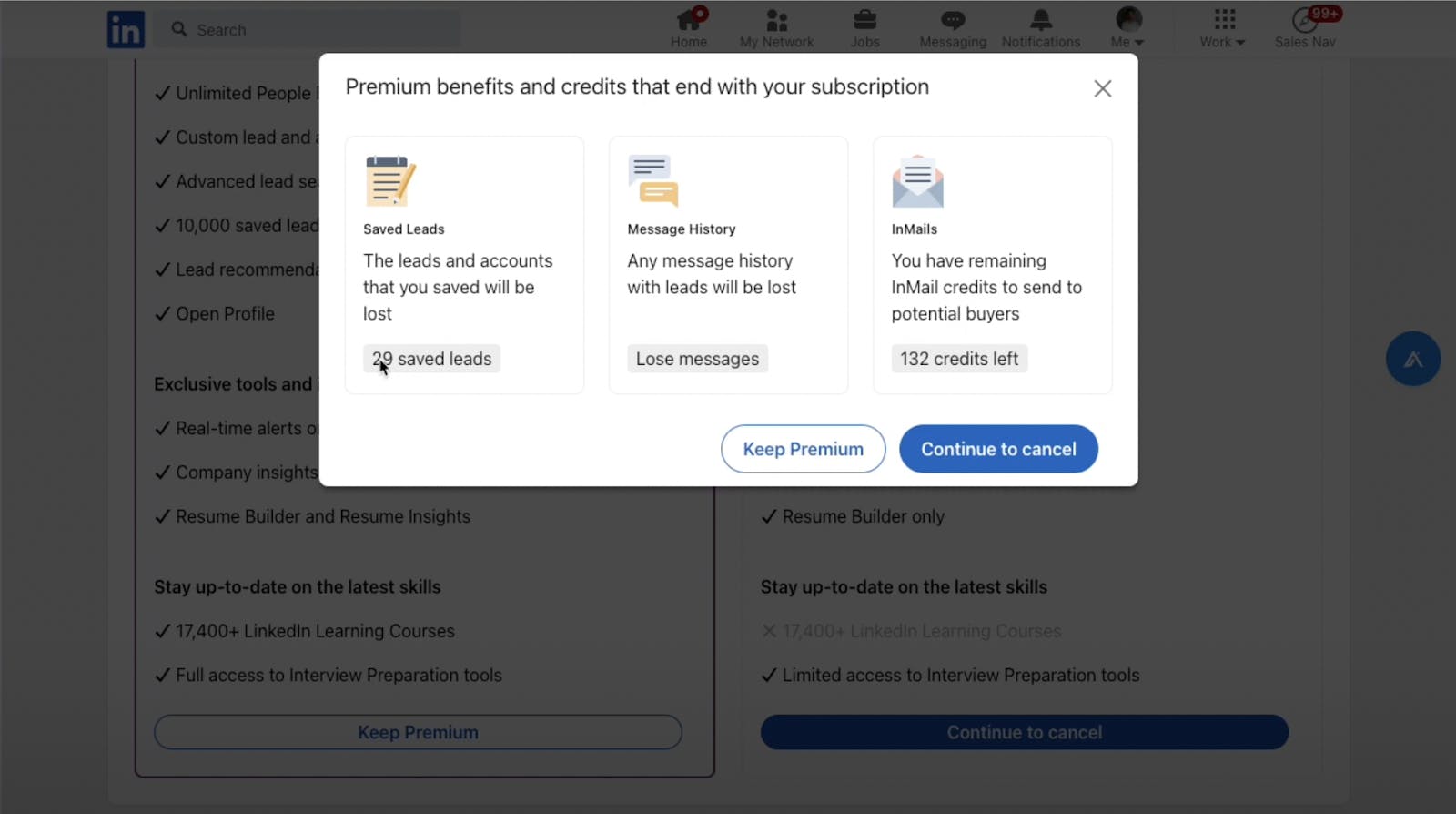
Send a Positive cancellation Confirmation Email
Remember: If the last interaction was friendly and respectful of the customer's decision, you'll do two things. First, your customers are more likely to come back. Second, we do not spread negative reviews to the public.

Nurture and Re-Engage
Check out and monitor the reason for leave. If someone is leaving because you have less feature than competitor, offer them when you introduce new feature. If someone's leaving because your price is higher, retarget them if you are running a discount or life-time deals.
As your company or product matures further or overcomes previous inefficiencies, you can try to win back customers with new value propositions.
Cancellation Flow: Top 3 Examples
Linkedin
LinkedIn asks users a simple survey question if they want to cancel their premium subscription. There is a simple multiple-choice question and an "Other" option to give the user a specific reason for cancellation.
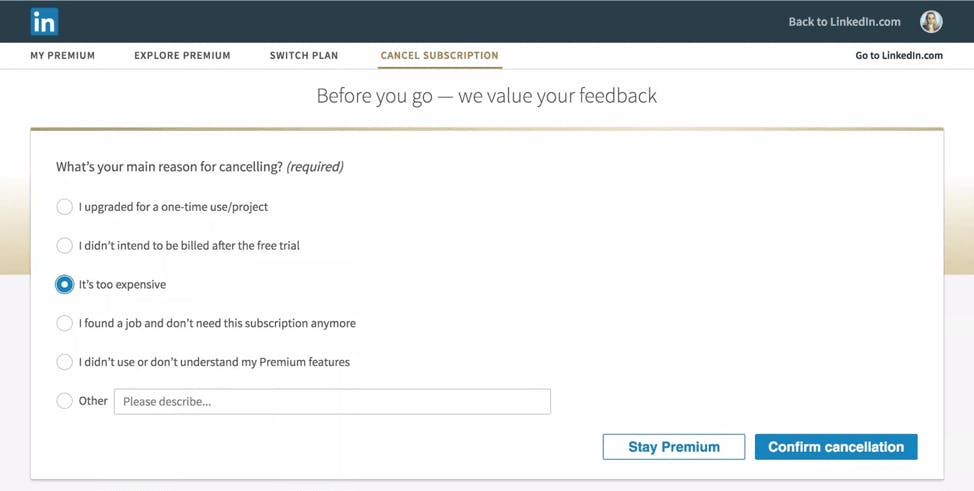
If you choose to confirm your cancellation, you will usually be offered a discount option to entice you to the platform. This is a simple but effective way to encourage them to continue using the product.
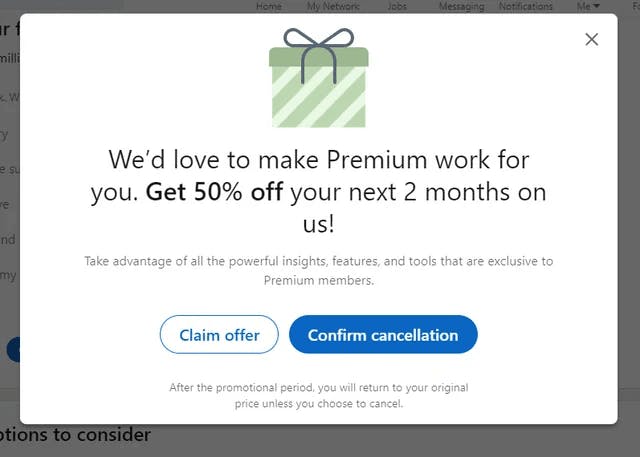
Mailchimp

Mailchimp does two things here. First, it notifies users that the pause feature is only available to premium users, providing value even if users want to cancel. Second, users can pause billing and come back at any time if they want to run the campaign again.
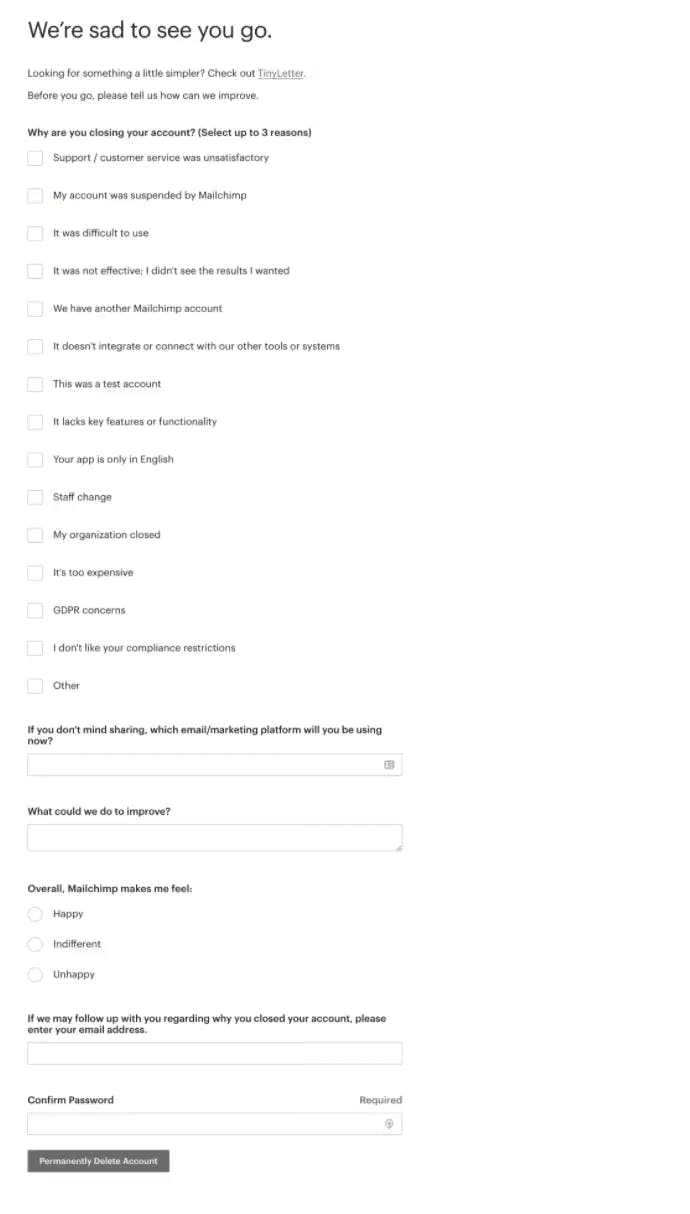
You could argue here that Mailchimp's survey forms are very long and have too many open-ended questions. I recommend limiting your open-ended questions to one or two, which will hopefully give you personalized data to analyze user churn. My advice is to experiment and see if the user completes the cancellation process. If not, you need to change it.
Zoom
Zoom has a simple flow. You will be asked to select a simple survey form for cancellation. You can also provide further feedback in the comments section below.
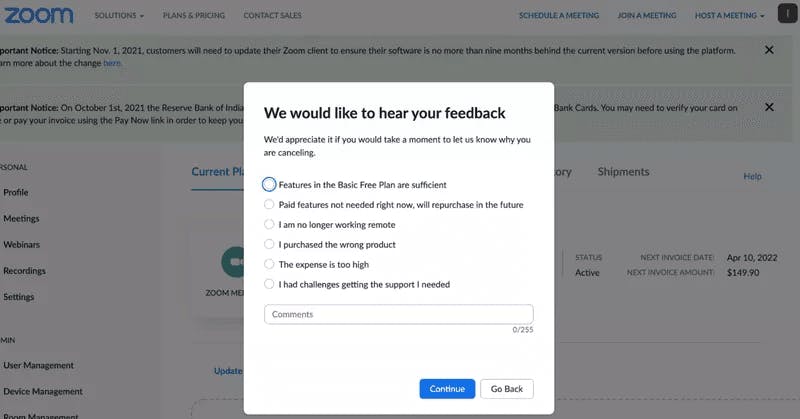
Now, when you have decided to continue, they are offering you an alternative option with a discounted price for a month. Neat and clean.

Final Words
I will say this: There is no one-size-fits-all cancellation flow. Feel free to experiment with yourself and see what works for you. Take inspiration from standard practices and what is working for similar businesses like yourself. Make that your starting point, but don't depend fully on it.
Make use of exit surveys, create unique incentives for each user to benefit by leveraging the survey data, and keep experimenting.

